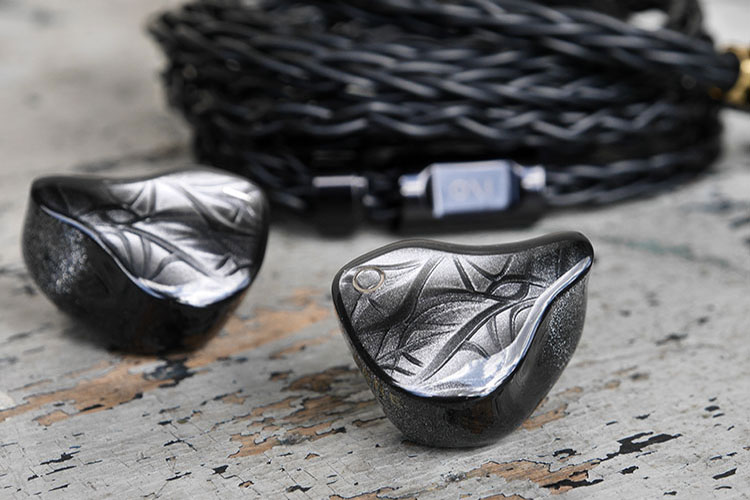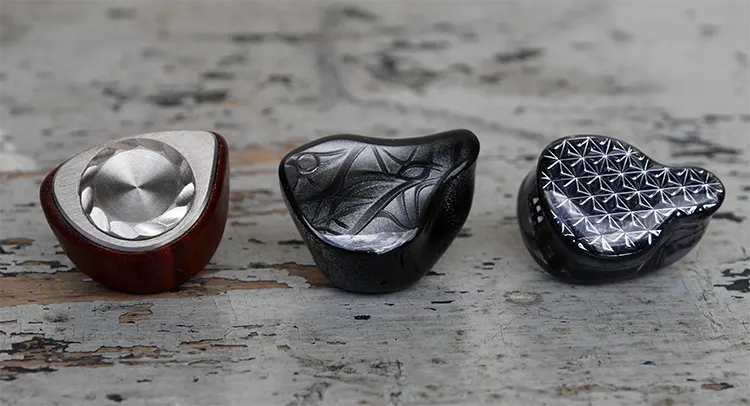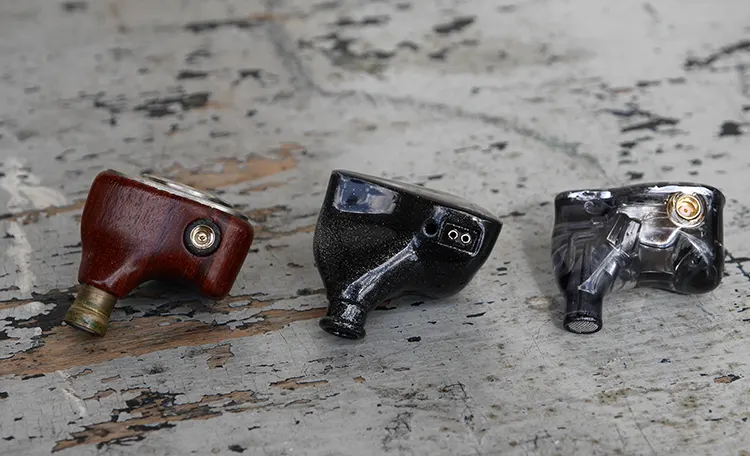Select Comparisons
Astrotec Phoenix
Technical
The I/O VOLARE and Astrotec Phoenix each contain multiple electrostatic drivers and a single dynamic. The Phoenix omits any balanced armatures of which the VOLARE utilizes four.
While I/O Audio provides plenty of information on their newly developed dynamic driver, the one in the Phoenix remains a mystery.
The build on these earphones is also entirely different. We have 3D-printed resin for the VOLARE, and a mix of rosewood, aluminum, and titanium for the Phoenix with brass nozzles to round things out.
The VOLARE is infinitely easier to bring up to volume than the Phoenix. Also, the impedance of the VOLARE is a scant 4.8Ω to the Phoenix’s 32Ω.
Design
Astrotec’s Phoenix has a similarly ergonomic, curvaceous design to the VOLARE, but with less exaggerated bums and lumps. I suspect this comes down to the primary material choice, rosewood, which requires a certain thickness to maintain structural reliability.
The Phoenix is quite a bit smaller in terms of length and depth, making it the more low-profile model of the two. A thinner, lighter cloth cable and slenderer nozzle round out its ergonomic advantages.
The visual appeal of both models is strong but for completely different reasons. The VOLARE looks more modern thanks to the use of metallic flake-imbued resin.
Astrotec took a more traditional hi-fi route using rosewood and raw metal for the faceplates. It has an old-school charm that fits with classic 60s and 70s hi-fi stereo equipment from Marantz and the like.
If using a third-party cable, both models make this easy. The Phoenix’s MMCX ports are slightly raised, ensuring any compatible cable will fit without any qualms.
VOLARE’s ports are slightly recessed, but not to the point where it caused issues on any of the cables I tested. Still, that recession will cause problems with some plugs, so Phoenix’s design is more accommodating.
While both isolate exceptionally well, the Phoenix has a sealed design and blocks out even more external noise. Add to that significant resistance to buffeting wind, and the Pheonix provides a superior experience.
Performance
As outstanding as the low end of the VOLARE is, the Phoenix’s custom driver is still the one to beat. It provides even better extension, is just as fast, notes hit harder, and more importantly, note texture is rife with detail and not nearly as smoothed over.
Jumping into the mids the VOLARE sounds more natural, and instruments and vocals are even more clear and defined. The VOLARE’s mids are also more forward giving it a more balanced presentation, though I wouldn’t consider either model balanced.
Treble on both models is extremely detailed with a snappy decay and vicious attack. The VOLARE’s electrostatic drivers are tighter with better note definition and have a more even balance of lower and upper treble emphasis with more sparkle and energy throughout.
Heading into staging, both models are top-tier picks. They both have a vast, well-rounded sound stage that envelopes the listener, though the Phoenix’s default vocal positioning is slightly further away, giving it just a hint of more space to work with.
Technical qualities also go head-to-head with smooth and precise channel transitions alongside well-separated and layered instrumentation.
Overall, the VOLARE is the more mature-sounding earphone with a better, more complete tune. Still. the Phoenix’s high-quality bass and impressive technical chops ensure it’s not left behind.
FiiO FA9
Technical
Both the VOLARE and FA9 used 3D-printed acrylic for their shells. While they are both constructed to exacting standards, the VOLARE has a notable advantage with its nozzle design and the effectiveness in how it holds tips of various sizes and styles.
The VOLARE is a tri-brid containing 4 ESTs, 4 BAs, and one dynamic driver. The FA9 is a pure armature setup and contains 6 BAs per side.
Like the VOLARE the FA9 contains a 4-way electronic crossover, along with physical tuning handled via an 80.6mm long sound tube. It also brings to the table switches to alter the tuning and drivability further, something the VOLARE does not offer.
The VOLARE has a sensitivity of 121 dB @1kHz compared to the FA9’s 110-113 dB @1kHz rating. The VOLARE’s impedance is 4.8Ω to the FA9’s 16-32Ω weighted measurement.
Design
FiiO’s FA9 has a similar shell design to the VOLARE, though the VOLARE is negligibly longer with the main size difference being in how deep the body is. This results in the FA9 fitting into the ear with a lower, sleeker profile.
The FA9’s smaller shell and leaner nozzle (5.6mm at its widest) give it the edge for a universal fit across a wider variety of ear types. It also has a thinner cable with lighter, more compact hardware, further benefiting its ergonomic advantage.
While looks are subjective, I think both models are stunners. The geometric faceplates on the FA9 contrast nicely with the VOLARE’s more organic lines.
The VOLARE is the more visually appealing overall thanks to the metallic flakes integrated into the resin. It gives the visual experience a level of dynamism the FA9 can’t match unless you prefer to see the internal structure of the drivers and sound tubes.
Both models will accommodate third-party cables if you wish to swap out the stock option. The FA9’s MMCX ports sit flush with the body, and while the VOLARE’s 2-pin ports are slightly recessed, it’s not enough to hinder the fit of most cables I tried.
Isolation on both models is outstanding. Outside noise is dulled significantly on both models without needing foam or multi-flange tips to improve things further.
The FA9 provides a superior isolation experience though. This comes down to the lack of wind noise, something the VOLARE suffers too much from.
Performance
The FA9 was used exclusively with the dip-switch system in the OFF/ON/OFF configuration for increased treble and bass.
Bass performance on both is excellent, with the FA9 offering more texture and a slight speed advantage alongside less emphasis. Otherwise, the VOLARE’s dynamic hits harder and has a better note definition. It provides more impact, extends further, and gives a more visceral experience in general.
Heading into the mids, the VOLARE provides a more natural and realistic presentation with improved timbre quality over the FA9. Vocals are also clearer and more detailed with greater coherence during busy passages.
Heading into the treble the VOLARE sounds more natural, is more detailed, and most importantly, has a tighter, cleaner note presentation. Extension is also improved and the additional sparkle in the VOLARE’s presentation helps make it livelier.
The FA9’s sound stage is nearly as wide and deep as the VOLARE’s, but it lacks the same air between notes making the perceived space lesser. The FA9 is also a step behind when it comes to imaging precision, layering, and instrument separation.
The FA9 is a wonderfully tuned earphone with outstanding bass for an all-armature setup, but the VOLARE manages to one-up it in every aspect, save for low-end texturing.
My Verdict
I/O Audio’s first release is a resounding success. While not inexpensive by any means, it severely undercuts similarly spec’d models from competing brands by a significant amount.
Despite this huge price advantage, I wouldn’t say they cut corners and compromised the VOLARE. The design is visually appealing, it is wonderfully constructed, the accessory kit is outstanding, the unboxing experience is very premium, and the three driver types used were implemented in a refined, exceptionally competent manner.
There is some room for improvement though. Their unique dynamic driver could benefit from some additional texture, and the 2-pin system could benefit from improved tolerances.
While the stock cable is excellent, the locking mechanism is clumsy. I also don’t think it fits the aesthetics of the earpieces.
Even with these areas for improvement, the VOLARE is a stellar set of universal IEMs, and I cannot recommend them enough. If you’re looking for an IEM in this price range and are willing to try something from the new kid on the block, it would be a shame to overlook the VOLARE.
I/O VOLARE Technical Specifications
- Frequency Response: 10Hz–40kHz
- SPL: 121dB/Vrms @ 1 kHz
- Impedance: 4.8 Ohms @ 1 kHz





